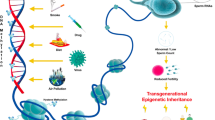Abstract
IN making estimates of the damage caused by exposure of human gonads to ionizing radiation, it is essential to take into consideration variations in sensitivity of the germ cells at different stages in their development. In Drosophila, this has been done by mating irradiated males to a succession of females and determining mutation-rates separately for successive broods1. It was found that spermatids, probably at the stage of transformation into spermatozoa, are the most sensitive stage; mature spermatozoa are one-third or one-fourth as sensitive as spermatids, and spermatocytes are intermediate. Spermatogonia are the least sensitive: a given dose of X-rays produces only one-third to one-half as many mutations in spermatogonia as in spermatozoa.
Similar content being viewed by others
References
Lüning, K. G., Hereditas, 38, 91 and 108 (1952). Auerbach, C., Z. indukt. Abstamm. u. VererbLehre, 86, 113 (1954). Khishin, A. F. E., Z. indukt. Abstamm. u. VererbLehre, 87, 97 (1955).
Hertwig, P., Biol. Z., 58, 273 (1938).
Russell, W. L., Russell, L. B., and Kimball, A. W., Amer. Nat, 88, 269 (1954).
Author information
Authors and Affiliations
Rights and permissions
About this article
Cite this article
AUERBACH, C., SLIZYNSKI, B. Sensitivity of the Mouse Testis to the Mutagenic Action of X-Rays. Nature 177, 376–377 (1956). https://doi.org/10.1038/177376a0
Issue Date:
DOI: https://doi.org/10.1038/177376a0
- Springer Nature Limited
This article is cited by
-
A chemically-induced variegated-type position effect in the mouse
Zeitschrift f�r Vererbungslehre (1961)
-
The sensitivity of the mouse testis to the mutagenic action of triethylenemelamine
Zeitschrift f�r Vererbungslehre (1959)
-
Untersuchungen zur frange der genetischen Wirksamkeit von Myleran anDrosophila melanogaster
Zeitschrift f�r Vererbungslehre (1959)
-
Mutagenic sensitivity of maturing germ cells in the male mouse
Heredity (1958)
-
M�gliche Ursachen der verschiedenen Strahlenempfindlichkeit des Erbmaterials in Keimzellen unterschiedlichen Alters
Die Naturwissenschaften (1958)





